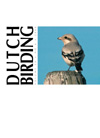Dutch Birding volume 30 (2008) no 4

Atlas Chaffinches at Eemshaven in April 1999 and at Maasvlakte in April 2003 and observations in Europe
On 30 April 1999, a female Atlas Chaffinch Fringilla coelebs africana was briefly observed by a small number of birders and sound-recorded at Eemshaven, Groningen, the Netherlands. Although some plumage features (including a predominantly greyish plumage with a green mantle and back and bright-green rump) were noted, it was accepted mainly on basis of two calls: a frequently heard loud sparrow Passer-like chep call and a once recorded soft rising whit flight call. The distinctive chep call occurs in both Atlas Chaffinch and Tunisian Chaffinch F c spodiogenys and excludes all other subspecies of Common Chaffinch. According to recent research by The Sound Approach, the flight call also excludes Common Chaffinch F c coelebs and differs between Atlas and Tunisian, showing that the bird was in fact an Atlas. It was accepted as a female because of its mainly greyish plumage and weak face pattern; the green mantle and back are often given as a feature of males Atlas Chaffinch but this character appears to be variable and females can show quite a strong green coloration on the upperparts.
On 4-5 April 2003, an adult male Atlas Chaffinch was observed by many birders at Maasvlakte, Zuid-Holland, the Netherlands. It was accepted on basis of, eg, the sparrow-like chep call, the greenish mantle and rump, blue-grey uppertail-coverts and prominent pink wash on the underparts, excluding Common Chaffinch (and also Tunisian Chaffinch).
These are the first and second records of Atlas Chaffinch for the Netherlands, and the northernmost for Europe. Although this taxon does not migrate over large distances, it mixes with wintering flocks of European Common Chaffinches and (scarcer) Bramblings F montifringilla in north-western Africa. It seems feasible that they join migrating flocks northward across the Mediterranean after which, being essentially non-migratory, they may never return south. In table 1, all c 10 reports of (presumed) 'African Chaffinches' F c africana/spodiogenys in Europe are presented, showing a peak in February-April (figure 4), coinciding with the peak in spring passage of nominate Common Chaffinch in north-western Africa. Being non-migratory and not particularly common in harbours, ship-assisted passage to north-western Europe is unlikely. A captive origin, however, can not be fully excluded; for instance, there is a report of several 'African Chaffinches' allegedly taken into custody from illegal traders and released in Noord-Brabant, the Netherlands, in April 2008.
The true pattern of occurrence of 'African Chaffinches' in Europe is clouded by the fact that many reports are not well documented, not submitted or not considered by national rarities committees. Furthermore, their status in Europe is obscured by the regular occurrence of (presumed aberrant) Common Chaffinches looking like 'African' in (some) plumage features. There have been c 23 reports of such 'look-alikes' (see table 2; note that this list may include some genuine but insufficiently documented 'African' - and vice versa for table 1). One of these birds stayed at Haren, Groningen, the Netherlands, from 28 November 2003 to 6 January 2004 and is documented in appendix 1; at the time, it was considered - and published - as an 'African' but was rejected by the Dutch rarities committee (CDNA) on basis of a few anomalies in its plumage; no vocalisations were documented. The origin of 'look-alikes' is unclear and may involve hybridisation, genetic disorder or (undocumented) plumage variation in Common Chaffinch and/or 'African Chaffinch'.
Marnix Jonker, Boslaan 22, 9636 GM, Zuidbroek, Nederland
(mjonker home.nl)
home.nl)
Rik Winters, Aquamarijnstraat 60, 9743 RB, Groningen, Nederland
(groenebijeneter home.nl)
home.nl)
Arnoud B van den Berg, Duinlustparkweg 98, 2082 EG Santpoort-Zuid, Nederland
(arnoud.vandenberg planet.nl)
planet.nl)
terug






